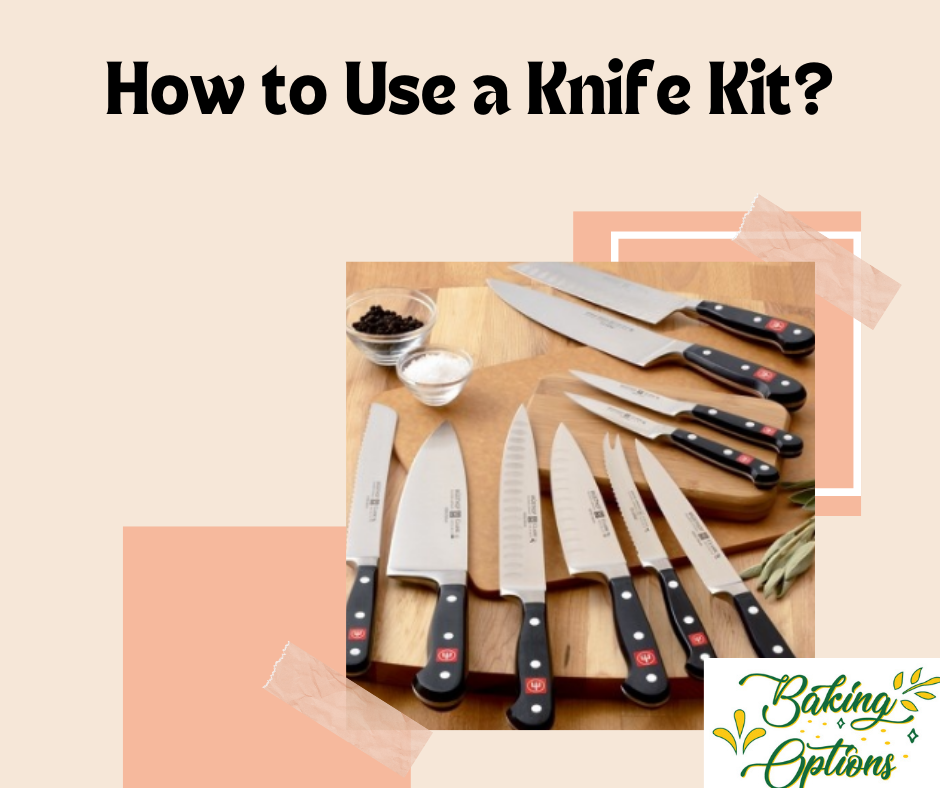Do you have a knife kit and don’t know how to use it? Well, this is a common situation in our kitchens; many items are available whose purpose we don’t even know. This issue especially arises with beginner chefs. In this article, I will clarify how to use a knife kit.
We use different knives for different purposes; some are for thin slices, some for regular cutting, and others for dicing.
Once, I watched a video on Facebook where a professional chef skillfully cut vegetables into very thin slices. I was shocked at how someone could cut so perfectly.
Then, my friend told me that different types of knives are used for other purposes. I was a beginner then, but now, with my knowledge, I will share it with you so that beginners can use it correctly.
Contents
Types of Knives in a Kit?
Different types of knives exist in a knife kit. However, it depends on which company’s knife kit you have chosen because some kits have a combination of knives while others might have different ones. But there are some everyday kitchen knives that you might find in a kit, and I will explain their names and purposes one by one.
I have a knife kit with 5 knives, and I will share the characteristics of those knives with you.
1. Bread Knife
It’s a very common knife because its blade is long and usually designed for slicing. If you are a professional chef, this knife should be in your kit. However, if you are unsure about its purpose, I will clarify that now. I use it; it is the best knife for cutting specific bread types with a rugged exterior and a soft interior. Its blade is 9 inches long and can easily cut all kinds of bread.
Use of Bread Knife
Slicing Bread
The primary purpose of this knife is to cut bread with a thick, inedible crust so that the inside does not get spoilt. It includes all types of bread, such as baguettes, brioche, pita, and all other bread categories.
Cutting Baked Goods
The tool is also ideal for slicing baked merchandise such as pastries and cakes to avoid crumbs forming.
Preparing Fruits and Vegetables
The sharp edge is also most appropriate when cutting soft fruits such as tomatoes, peaches, and apples or hard-skinned foods such as melons and pineapples.
Carving Meat
Sometimes, it is also possible to cut cooked meats, including roast beef or turkey, with a bread knife, whereas it is impossible to get clean cuts with a bread knife when slicing bread.
Chocolate Breaking
When baking is involved, it helps slice solid chocolates into pieces.
2. Boning Knife
A boning knife is a specially made, highly versatile tool used to debone meat products. It is simple to cut around cartilage & bones due to its long, thin blade. Usually used for complex & delicate work, this knife ranges from 5 to 7 inches.
Uses of a Boning Knife
Deboning Meat
Its primary use is depilatory; for example, you can strip bone from pieces of meat, such as chicken or fish.
Trimming Fat
It also makes removing the skin from meat and other extra fats around the meat possible.
Vegetable Preparation
The flexibility of the blade is ideal for peeling or slicing fruits and vegetables.
3. Chef Knife
A kitchen kit is not really useful if it does not include a chef knife. Chefs usually use these, but a professional kitchen kit should have at least one chef knife. Anyway, looking at its characteristics, the blade length ranges from 8 to 12 inches, and you can use it for different purposes.
Uses of a Chef Knife
Chopping and Dicing
They are perfect for preparing vegetables, herbs, and fruits, such as chopping.
Meat Preparation
I usually use it to chop chicken wings or other parts requiring a relatively thick and powerful tool.
General Kitchen Tasks
It has numerous uses in cooking, making it indispensable in the kitchen and food preparation.
4. Cleaver Knife
A cleaver is known for its wide, thick blade that is efficient for heavy-duty work. It is traditionally used in butcher shops and is approximately 6 to 10 inches long, depending on the use.
Uses of a Cleaver Knife
Butchering Meat
Mostly used for cutting through bones & hard pieces of meat.
Slicing Vegetables
Good for cutting through tough vegetables like squash.
Crushing Aromatics
Due to its flat surface, you can use it to crush garlic or ginger.
5. Utility Knife
A utility knife is one of the versatile tools used in the kitchen. Its length varies from 4 to 9 inches. It exists in between the paring knife and the chef knife. Thus, it can perform various cuttings.
Uses of a utility knife
General Cutting Tasks
I use it to halve fruits, slice bread, and chop herbs with the utmost control and convenience.
Slicing Smaller Ingredients
It is excellent for cutting smaller items such as cherry tomatoes, radishes, and delicate herbs, where larger knives are clumsy.
Handy Tool
It is a convenient tool for daily convenience, making it essential for quick kitchen tasks, such as trimming meat or opening packages, and it is also handy for outdoor activities like picnics or barbecues.
Basic Knife Using Skills for Beginners
1. The Claw Grip
The claw grip is a general step for holding the food under the knife. Just curl the fingers inward in a claw-like manner. When cutting, you should pull your fingertips back and use your hands to hold the knife.
Why It’s Useful: It doesn’t only make sure that your fingers don’t come into contact with the blade in case it slips, but it also helps support the food you are cutting. To control the cut better, you must have your finger curled and your fingers touching the knife’s edge.
Practice Tip: First, it is advisable to exercise this grip when holding tender fruits or foods like tomatoes. I recommend it at a slower rate and gradually speed. The more familiar you become with this grip, the safer you are in smooth cutting.
2. Rocking motion
Rocking motion is a more helpful technique to increase speed and precise chopping. To make this motion, position the knife ball across the chopping board and swing it up and down like a rocking motion.
How to Do It: Place the knife at the edge of the board, place some light pressure, and move the handle upward while maintaining contact with the board. It is the machine’s rocking movement to chop the ingredients within a short duration and equal size.
Copping Vs. Slicing
- Chopping
It creates tiny, consistent pieces by quickly moving the knife up and down. Chopping is best for onions, carrots, or nuts, where size consistency is essential. The goal is to make pieces of equal size so that they will cook at the same rate.
- Slicing
However, slicing needs more control. You pull the knife across the surface of the food to cut it evenly. This technique is best; I use it for meats, tomatoes, or bread when need clean cuts without crushing or tearing.
How to Use a Knife Kit Safely
1. Sharp Knives
- Why Care: A dull knife is often more hazardous than a sharp knife. A dull blade requires considerable pressure, and that increases the possibility of slipping.
- Maintenance Tip: Hone your knives frequently using a sharpening stone or hone rod. A sharp knife slides through the ingredients. It is much easier to maintain control, thereby reducing the risk of accidents.
2. Sturdy Cutting Board
- Stability is Key: Ensure your cutting board doesn’t slip while chopping. A steady surface is crucial for preventing accidents.
- Easy Fix: To keep your cutting board stable, place a moist cloth or paper towel underneath it. This simple trick creates a stable surface whether you’re chopping vegetables or preparing meats.
3. Store Knives Properly
- Safe Storage: Safe storage of knives is an issue of both safety and maintenance. Always store your knives in a knife block or magnetic strip.
- Avoid Drawers: Never put knives in drawers where they tend to knock about with other utensils. Hurling knives around causes cuts and dull blades. Proper storage protects you from cuts and keeps the blade sharp.
Final Thought
To use a knife kit safely, you can try on soft fruits, and afterward, you can sharpen your knife on them like bananas. A quality knife set improves the cut of your culinary items, making the experience much more fulfilling. Be slow; learning knife skills may begin slowly before anything regarding speed as you become more confident.

